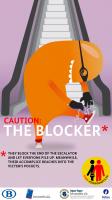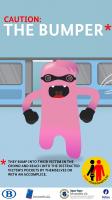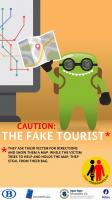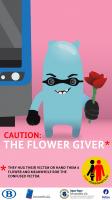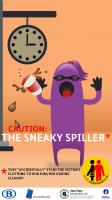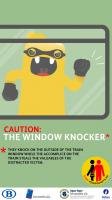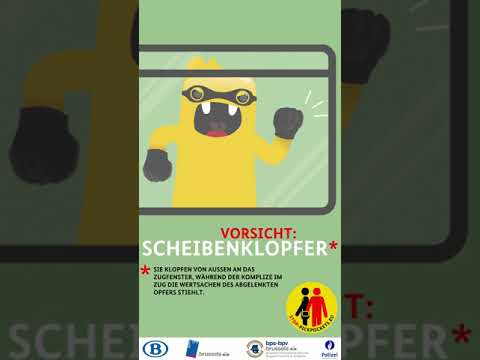Stop Pickpockets
The Belgian Railway Police (SPC) will take part in a coordinated European awareness campaign from 22 June 2021. The campaign aims to alert passengers to the phenomenon of trick theft and pickpocketing in the railway environment. The campaign’s eye-catchers are six little monsters, each of which in turn depicts a common modus operandi. The campaign will remain visible throughout the summer and will be given extra emphasis during attractive events such as the European Football Championship.
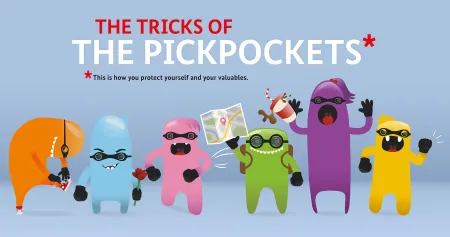
European Awareness Campaign Railway Police
Germany, as the organising country, is leading the campaign. Together with international institutions (Europol, European Crime Prevention Network/EUCPN, European Multidisciplinary Platform Against Criminal Threats/EMPACT), almost 16 countries have joined the project. The Belgian campaign will initially focus on the locations identified by our own statistics, i.e. in the Brussels conurbation, and more specifically on the five main stations in Brussels: Central, South, North, Luxembourg and Schuman. To this end, SPC cooperates with numerous internal partners (Integrated Police) and external partners (STIB-MIVB, SNCB, Brussels Prevention & Safety/BPS, etc.) to strengthen coherent and integrated communication on this common problem and on the current campaign. For example, the Brussels Capital Ixelles police zone will support this campaign by soon distributing videos on how to see through pickpocket tricks, as will the Brussels North police zone since it also has one of the largest train and metro stations on its territory.
Organised crime
The phenomenon of trick theft and pickpocketing is quite widespread. The actual figures remain uncertain, but it is estimated that the number of registered complaints should be doubled. In Europe, Belgium has one of the highest rates of non-violent theft in relation to the number of passengers on the railway network.
Contrary to what one might think, this is in fact organised crime or so-called Mobile Organised Crime Groups (MOCG), as its essential components are present: systematic and systematised actions; usually perpetrated by several persons, in gangs, with defined roles; with the aim of violating the property of others and with an international dimension because of the targets, the field of action, the methods and the perpetrators.
Six monsters, six pickpocket tricks
Pickpockets are always on the move! They take advantage of the crowding in railway stations or trains to strike undetected. Most trick thieves and pickpockets work in teams and collaborate with each other: for example, whilst one of the thieves distracts a person, an accomplice will steal from them. Be alert, look after your belongings and protect yourself against theft! They have a varied repertoire. We present you the most common methods below:
THE BLOCKER
They block the end of the escalator and let the victim and others pile up. While everyone is looking ahead, their accomplice reaches into the victim’s pockets from behind.
THE FLOWER GIVER
They greet their victim in a friendly way, hug them or hand them a flower. While the victim is confused, their wallet disappears.
THE WINDOW KNOCKER
They knock on the outside of the train window. The accomplice on the train steals the distracted victim’s valuables.

THE SNEAKY SPILLER
They “accidentally” stain the victim’s clothing. During the cleaning up, the money disappears from the victim’s pockets.
THE BUMPER
They bump into their victim in the crowd or attack in pincer formation with an accomplice. While the victim is distracted, they or their accomplice reach into the victim’s pockets.
THE FAKE TOURIST
They ask their victim for directions and show them a map. While the victim tries to help and takes the map with both hands, they steal from the victim’s bag.

Travellers, business people, tourists, shopkeepers, etc. will come into contact with these six little monsters through visual messages (posters, flyers, information boards, etc.) in the stations. Potential victims will also be warned via social media (Facebook, Instagram, TikTok, websites, etc.). Finally, targeted police actions are planned.
Tips against trick theft and pickpocketing
The most important tip: leave cash at home! Do not let anyone distract/approach you. Use – now especially in times of Corona – that one-and-a-half metre distance. Do not put a mobile phone or wallet in your trouser pocket and carry your bag with the opening at the front, not on your back. Keep handy numbers at hand, such as your mobile phone’s IMEI number (which appears when you enter *#06#) and the Card Stop number (070 344 344).
Have you become a victim?
If you have become a victim, contact the police as soon as possible and report the theft. Give them a clear description of what has been stolen, and possibly also of the suspected perpetrator. Try to indicate as accurately as possible the exact time and place of the events, so that the police can work with the camera images. Your help can prevent others from becoming victims too that day!
At www.besafe.be you will find more tips on how to prevent trick theft and what you can do as a victim.
More information about the international campaign, including the modus operandi of the six monsters, can be found at www.stop-pickpockets.eu. There is also a link to a YouTube video with a short animation behind each monster.

